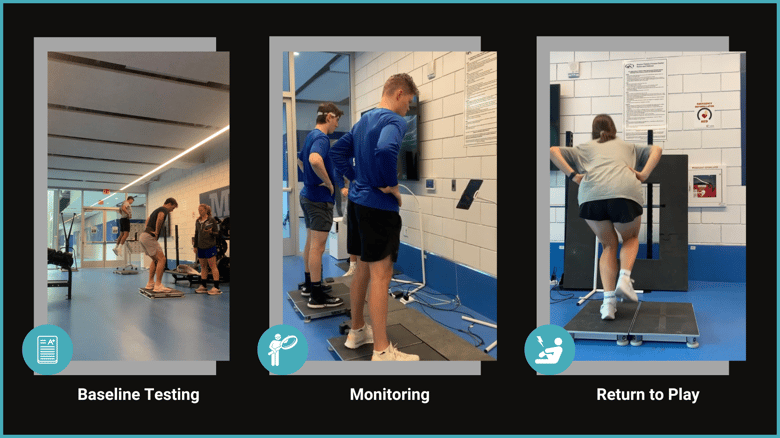A Quick Recap...
In Part 1 of this series, we discussed how to create a repeatable, predictable, and sustainable way to organize your strength and conditioning program. We touched on communication across the entire athletic department from administration to sport coaches, noting the importance of setting boundaries while also knowing the value of those that have stock in your success. We also discussed the many considerations you should account for including your facility size, staffing, sports, and schedule amongst many others when building out your program. Lastly, we gave you insight into what a successful program at Colby College looks like.
The Next Step - Adding Technology
Once your strength and conditioning program has been operating smoothly (for us one full academic year) and you feel as if you’re ready to advance your training, it is time to look towards adding technology. The main points we will focus on today will be the human capital required to operate the technology, user-friendliness and overall implementation of said technology into your setting.
.png?width=1920&height=1080&name=GregBlog2_Technology%20(1).png)
Here are some considerations when selecting technology to use in your program:
-
Which staff member will be primarily responsible for not only collecting the data, but also managing the technology itself? All technology requires power, charging, maintenance, troubleshooting, etc. Who will be responsible for these day-to-day duties? Who will be in charge of keeping up with current literature and best practices for implementing this technology?
-
What is the end goal of using this technology? Where will we start and where will we go?
-
Who will be the primary person that will be informed by this data? Will it be just the strength and conditioning department? Will the sport coaches also be looking at this data? Will sports medicine also look at this data to aid in their decision-making? How will the answers to these questions determine what technology will be implemented?
What kind of tech are we talking about?
Below I’m going to outline a few of the more popular options that people look to when they’re making the decision to add technology to their new training program. From my experience and conversations with other coaches, the first three pieces of technology people look to start out with are heart rate monitors, velocity-based training (VBT) units, and jump devices to track readiness & benchmark athletes (i.e. force plates or jump mats).
.png?width=1920&height=1080&name=GregBlog2_Technology%20(2).png)
Heart Rate Monitors
Heart rate monitors are a great tool if you have the resources to manage them. I say this because there are more moving parts to heart rate monitors than most initially realize. In the small college setting, I believe the ideal way that these should be implemented is that each team purchases and manages their own monitors. This means that the straps, receivers, and belts only live with one team and it is not up to you to manage who has how many and when etc. Then you as the performance professional only use your time looking over the data from each practice, game, or other session rather than tracking them down. Heart rate monitors are very useful in that they can provide a numerical value to the loads experienced not only in practice/game but also in specific drills which have implications for game preparation. Heart rate monitors can provide this valuable information to those involved with the care and development of the team.
Heart rate monitors themselves, like all technology, are not cooperative all the time. We found that during our time using Firstbeat (since 2020-2021) that when they are working as intended, the data is excellent and paints a great picture of what the athletes are experiencing while performing work. We had most of our issues with the units not connecting to the computer in cold climates, or other inclement weather. (*note Firstbeat does have units that can be used independently from a computer and this is what I use for my own training and I have never had an issue.) If teams are anticipating data from these monitors but have issues gathering it or issues pairing and you as the strength coach are the only ones with the knowledge of troubleshooting - is this data going to get collected with any regularity that it can be consistently actionable? This is another reason why giving the respective sport coaching staffs ownership of the units is a good idea, especially since the place these are predominantly used is during practice sessions.
Our heart rate monitors were predominantly managed by our Peak Performance Director and the corresponding sport coaches. We had 60 belts that we would rotate between our in-season teams. Firstbeat’s dashboard does a great job of showing individual athlete and team training responses. Our soccer teams and ice hockey teams were the biggest users of these. The hardest part of using them is trying to get them to be used consistently and reliably enough that they collect the data you are looking for. Athlete compliance is sometimes lacking especially due to the reported discomfort while wearing the monitors.
If heart rate monitors are where you want to go with your technology and you will be the one making the decision I’d suggest getting a thorough understanding of how the profiles and belt assignments work. For us, we had to create new profiles and shuffle belts between individual athletes and it can get time-consuming and a lot of back ends to keep track of. If your sport coaches are going to be managing it and all you will be responsible for is reading the data, then these are a viable option. If you will be responsible for managing them including the batteries, the profiles, the storage, and everything else, then consider how much additional work this will add to your already full plate.
Velocity Based Training Units (VBT)
The use of VBT units in strength and conditioning has been around for decades. With the myriad of options available on the market, it is a viable and well-adopted option to add to a strength and conditioning program. VBT units are also probably the technology that most coaches reading this article will have the most firsthand experience or familiarity with. VBT allows a coach to program loading more precisely to meet the current readiness state of the athlete. VBT also allows coaches to manipulate the physical quality being trained by programming a specific bar speed for the athlete (i.e. strength-speed, speed-strength). VBT can also be used to assess readiness by training on an established percentage and looking at the speed of the barbell against a known norm for that load.
VBT options today are endless, but they require charging and management of connection to a network or Bluetooth to a tablet or other device. These are all logistical questions that you will need to answer if you decide to go this route. Unlike heart rate monitors, these are units that generally will only live in the weight room and will only be seen by the athletes and the strength and conditioning staff. This means that you will only have to consider yourself in the equation of management of the units themselves.
When we were selecting our VBT units for our facility I only ever considered getting Tendo Units given that I was most comfortable with them from my time using them in other facilities and appreciated the simplicity of the product. Knowing that in order to have success with implementing them that it was going to be up to the athletes to be able to operate the units effectively, this was a priority for me in selecting which units I was going to use. Once I started using them I realized that there were other positives as well. The primary one is that the batteries last nearly 6-months between charges even with our usage of 2-3 days per week over multiple sessions per day. The only issues we have with them are that the units only store 500 reps at a time, so we have to reset them periodically, something athletes also know how to do themselves now. We also had issues with setting up the correct “filter” length when using the unit with smaller athletes. Again, easily resolved by consulting the user manual and is now a non-issue. I never worry about these working as intended when I pull them out for a training session.
We are still slowly adding more VBT training prescriptions to more sports strength training. VBT is a great option, but it is difficult to add to the whole program given the barrier of entry and baseline training age required to really maximize the benefits of implementing this type of training. However, with the ease of use of some of these options and the variety of ways that they can be used, these are a great option if your department is ready for them.
*other common VBT options - GymAware, Vitruve, Perch, Eliteform
Jump Devices
Force plates and Jump Mats are often described in the same breath as they, on the surface, seem to accomplish the same thing. However, you will learn quickly they differ greatly.
In the simplest terms, they both are devices that live on the floor of a facility and are used by an individual performing a predetermined type of jump (i.e. Countermovement Jump) on them to gather data and produce an assessment based on the athlete’s current state from both a readiness and training status. Most importantly for those in a small college setting, both of these products are very easy to implement in an autonomous fashion. Our Hawkin Dynamics force plates are always on and connected to their corresponding tablets allowing us the opportunity to operate them during our training day. Across all of our sports, our athletes completed an average of 165 jumps per day during the 2021-2022 academic year. I have seen facilities that use a jump mat in a similar way, with athletes jumping as part of their daily training routine and logging the results on an app such as TeamBuildr or a sheet of paper. The data from the Hawkin Dynamics force plates is connected to the cloud, so automatically captures and creates a report for the session.
The volume of data collected and the ease of analysis of the data are the main differing factors between these two ways of analyzing jump data. Our force plates collect 1000 data points per second (i.e. 1000Hz frequency). These data points are all encompassed into nearly 100 different calculated metrics (i.e. jump height, modified RSI). All this information is then aggregated into the cloud platform automatically. The cloud allows us to quickly check in on what the trends are for a particular team via a multitude of reports. This affords us as a strength and conditioning staff the opportunity to draw our own conclusions. While we have a contracted sports scientist that helps us with a deeper dive into the data, it is not necessary to have one after the initial learning curve of navigating the cloud platform. A jump mat can only produce the data point corresponding to the four different settings you have the jump mat set at. While the data from the jump mat can be used longitudinally, this does require management of a spreadsheet and consistent updating and aggregating data. If one wants to do a different analysis such as RSI, then a different spreadsheet needs to be created. All this is possible to do as a strength and conditioning coach but is much more labor-intensive.
Additionally, force plates also provide information that gives insight into not only the output of the jump but how the jump was collected (i.e. jump time, phase changes, depth, left vs. right).

Force plates also crossover with sports medicine and sport coaches as well. For example, a force plate can be a great tool to use in athlete return-to-play protocols. We also have every athlete perform three countermovement jumps as part of their intake assessment in conjunction with our sports medicine’s PPE (pre-participation exam) process. This way we have a baseline on every athlete to reference should an athlete get injured. We can use the L/R discrepancies, countermovement depth, or the force-time curve of an athlete’s jump to compare to their post injury stats.
Force plates can also crossover with sport coach decisions by using them as a longitudinal measure of fatigue. A jump mat can also be used in this fashion but as mentioned above, this requires more backend work on the part of the strength and conditioning staff and is limited. We use our force plates to help coaches inform their decisions about practice intensity or if individual athletes are recovering from their current training load. It serves as an audit of the decisions that were made.
So Which Option is Best for Your Department?
Above, I outlined three of the more popular options for technology that coaches often consider when looking to add technology to their department. All have differing levels of impact or integration with the entire athletics experience and all require different levels of support and maintenance from the staff members responsible for them.
When it comes time to decide on what tech would be best for your department, I’d strongly recommend that you consider how many disciplines the technology can impact as a main deciding factor for your decision. This will give you a chance to show your knowledge and a willingness to include others in the athletic performance process. Below Is a simple chart that shows different disciplines within an athletic department and how these different technological components may impact these respective areas:
.png?width=1920&height=1080&name=GAINS%20CITY%20USA%20(2).png)
Discussion
Take the time to explore your options for the most bang for your buck technology considering the constraints of your position. But after using force plates for the last 3.5 years and becoming more efficient at collecting and analyzing the data via the cloud, I feel that force plates are a good place to start when it comes to adding technology. As I described earlier, they crossover multiple disciplines, are easy to use, and offer actionable insight in an easily digestible manner. The only negative about force plates and the type of data that they are typically used to collect and track need to be collected over the span of months to really gain a good understanding. There are some benefits to doing “snapshot” type tests, such as one-off max effort isometric tests or vertical jumps with arm swing. But the power of force plates is in the ability to track trends of different metrics over time and make decisions based on the big picture trends. This can be done with a jump mat like I said earlier, however it is much more labor intensive and not as information rich.
For us at Colby College, Hawkin Dynamics Force Plates were the first piece of technology we added to our department. In the time since, we have completed nearly 100,000 individual tests. It is by far and away our most consistent and heavily used athlete data collection and analysis tool.
Of the remaining two options outlined above, I’d go with VBT units of some kind second. While they impact less of the department than heart rate monitors, the user friendliness of the available options makes them much easier to implement than heart rate monitors. Additionally, similar data can be collected with VBT units as can be collected with force plates or jump mats. Admittedly, our Tendo Units sat in storage for the first year we had them. I was not comfortable using them in the current state of our program as we were trying to get our legs under us and get our athletes training consistently, which is a barrier to entry to using these types of products.
Conclusion
Technology is the trend in strength and conditioning right now, and the options are endless. These three options are the ones that we have intentionally and successfully integrated into our small college strength and conditioning program. When you are doing the same, remember to consider the human capital, the user friendliness, and how much impact this product can have on your athletic department before making your decision. Keep in mind that no technology or data is worth collecting if you aren’t able to reliably collect and analyze it day-to-day or week-to-week. Repeatable and reliable methods will always beat short-term flash.
Contact Greg
.png?width=1920&height=1080&name=Copy%20of%20GAINS%20CITY%20USA%20(2).png)
Send Greg an Email - with questions about this blog or about designing your program
Message Greg on Twitter - to follow what he's up to
Did you miss Part 1?

-2.png?width=156&height=60&name=Hawkin%20Logo%20(2)-2.png)
-1.png?width=155&height=60&name=WHITE.Horizontal_Logo.Transparent%20(3)-1.png)
